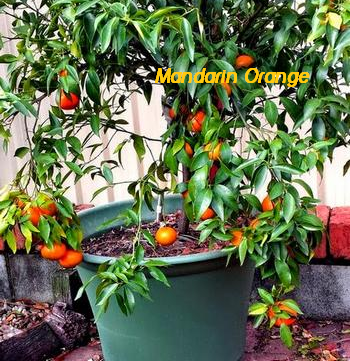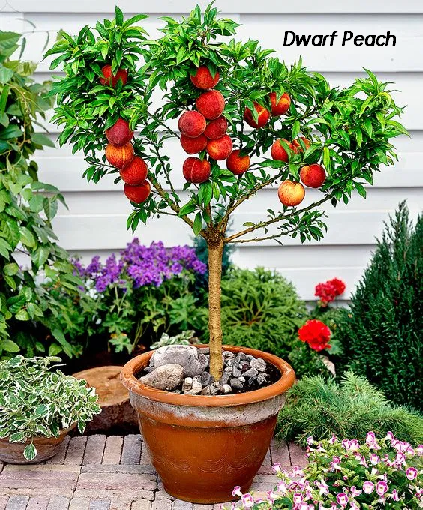|
What
you can grow successfully in containers and pots.
These are the large shrubs and trees growing in my gardens.

A young dwarf red weeping Japanese maple doing well in a big
pottery container in front of my window in the front yard. |

A young dwarf weeping tree in a big
plastic pot -so much easier to move around when i feel the need
to re-decorate the front yard. |
The
Japanese Maple

|
I have a small yard, and i love Japanese
Maple Trees.
I've come into them late in my gardening life.
Because
it didn't occur to me to grow them in containers. And because they grow
slowly. Now that I'm older, i'm in a hurry.
The Japanese Maple is pefect for
growing in containers. I have a few dwarf varieties that do well.
Japanese Maples are slow-growing and the weeping varieties have a
beautiful shape. They grow quite slowly, and can fit into any
landscape design i come up with. Containers not only add a great
decorative element, but your dwarf trees can be easily moved wherever
you want them.
These trees look very elegant and zen
in large containers. Japanese maples also play well with others, and
get along nicely with companion plants.
To grow these in large pots and
containers:
Choose a dwarf that matures at less
than 10 feet. There are many varieties of dwarfs. Larger trees will
also work if you prune them annually.
Select a container thatís no more than
twice the size of the roots. Make sure thereís a drainage hole.
Japanese maples won't survive long in consistently wet soil.
Use quality potting soil but
not one that contains fertilizer. Chemical fertilizer tends to burn
the tree's roots. I fertilize once a year with non-chemical natural
fertilizers.... Epsom Salts or Fish
Emulsion, diluted.
Prune in summer to shape the plant or to keep it at a
desired size. If i wanted to shape an upright variety into a weeping
shape, Individual branches can be trained to hang down by hanging
light weights on the branches for a growing season I hang ornments
on just about everything, so no one will notice unusual things like
small fishing sinkers on fishing line hanging on tree branches s to
train them.
Re-potting isn't necessary until
roots reach the sides and bottom of the pot, every few years. Prune
the roots by cutting away large, woody roots, to encourage small
fibrous ones to grow.
You can over-winter potted Japanese
maples in a protected spot after foliage drops in the fall. You can
keep them in a sunroom indoors, if you have one. You can also move
the plant to an unheated garage or basement, where temperatures
remain above freezing. The bonus is that no light is needed when the
tree is dormant. Keep the soil moderately moist until returning the
maple outdoors in the spring. Mine do fine outdoors in a sheltered
corner with other plants and survive my Zone 5 winter well. There
are many varieties that are cold hardy.
|
| I
have 2 of these Blue Wisteria Trees in big pots. One is staked and training
it's graceful branches onto the top of a decorative iron fence panel
enclosing an Asian-style garden. One is staked in a pot in the front yard.Wisteria is usually seen as a fast-growing
vine. Sometimes too fast and invasive, if growing wild or in the ground.
I stake and tie them to keep them straight and
growing in the direction I want them to grow. They're quite flexible.
The Blue Chinese Wisteria looks pretty
even when it's not in flower. Which is nice, because it may take several
years to mature to the age it needs to be to flower heavily or
predictably. It looks very delicate and graceful, like their vining
cousins, and lend an Asian feel to the garden. They are compact enough
to grow in the small corners or spaces in your front yard, next to your
porch, or on your patio.
In early summer - before the leaves
appear - the lavender blue hanging flowers can reach up to a foot in
length. They have a sweet fragrance. And the flowers appear before the
leaves, like my dwarf cherries. It grows fairly quickly and has a nice
look every season..
Butterflies and bees will be in
pollinator heaven. They grow almost in almost any zone in the U.S., and
they're growing very well in large pots. The fall color is an
awesome golden yellow. It needs no care whatsoever, except for maybe a
trim of the reaching ends once a year. Below is one of my container
wisteria trees drooping nicely with the help of a capiz shell windchime.
This pot is approximately 24 inches in diameter.
 |
 |
| I train my
5 lilac shrubs into tree-form. 2 are growing in big pots. You
can see where branches are cut off the main stem to keep it
growing up and not out. I need the trunk to get thicker to hold
up all those flowers. My lilacs are of the re-blooming variety.
One pot will be on the patio for the fragrance. |
Chinese Fringe Tree

|
The Chinese
Fringe Tree is an unusual, small flowering tree. Its spring
flowering is a treat, and it is attractive in fall, with reddish berries seen among yellow fall foliage.
It has fragrant flowers, and i find the
scent very addictive in the spring.. I had one growing in a
garden in the south, and I fell in love with it. It's a small
ornamental tree, and I am growing it in large pots in my
northern Zone 5 garden.
Lightly fragrant, feathery white
flowers almost entirely cover these trees for about two weeks
during the spring. In late summer and early fall, they will
produce an olive-shaped fruit that is not edible by humans
but is highly attractive to birds.
It is ideal for planting in urban areas, due to their pollution
tolerance and ability to adapt to a range of soil types. These
trees rarely need pruning .While they are young, you can prune
it to a single trunk or a standard multi-trunked form.
Once established, they require very
little maintenance. They grow well in USDA zones 5-9. It doesn't
take well to transplanting in the ground, so it will do great in
the pots.
|
|
Nandina
- "Firepower" Heavenly Bamboo

|
I've grown several varieties of nandina in a xeriscape garden
and in containers. They are great for gardeners like me, who
like to decorate the garden in a zen style using xeriscaping
techniques, and shape shrubs and trees into natural and pleasing
shape. Their stems are very similar to the bamboo i grow in
pots. I also like the fact that they are evergreen and will look
nice in winter.
Brilliant red foliage fall
through winter. It's hardy to zone 5. The others i've grown
aren't cold hardy.
Fire Power Nandina is often
chosen for the oriental effect they offer with their bamboo-like
stalks and fern-like foliage.
The green foliage turns a
brilliant fire red in fall, and lasting through winter., Great
for borders, mass planting, or container gardening. Requires no
pruning. I prune along the main stem for about a foot to mke it
look like a miniature tree. Evergreen. Mature Height and width :
2-3 Feet. They're quite happy growing in containers.
|
|
Dwarf
Bamboo

Bamboo is a large shrub, (about 6-8
ft. so i'm
calling dwarf tree), and
can be invasive unless
you grow it in a pot |
|
Grow
Ornamental Dwarf Fruit Trees In Pots

Bear
in mind that dwarf fruit trees bear the same size fruit as a
full-sized tree. The tree is dwarf, not the fruit.
Always
check the USDA cold hardiness map for the proper variety of dwarf
fruit trees to grow in your region.
Depending on the
variety and maturity of the plant and your growing conditions, it
may take several years for plants to bear fruit.
Choose a container
with good drainage.
A 12- to 14-inch diameter pot is suitable for two- and
three-year-old trees.
Dwarf citrus trees flower better when their roots are slightly
constricted.
Use a basic potting
mix (without fertilizers or wetting agents). Don't put gravel or
small rocks in the bottom of the pot.
Give trees a
thorough watering at first, then add 1/4 to 1/2 gallon of water
every five to seven days.
Place your tree in
a spot that gets at least eight hours of direct sunlight each day.
Citrus grows best when temperatures are between 55 and 85 degrees
F.
|
|

Easy to grow,
prolific and don't need a lot of heat for the fruit to ripen.
Slightly sweeter and juicier than the classic commercial varieties.
Meyer lemons have a slight tangerine flavor. i find it the
best cooking lemon. it doesn't break up likeregular lemons.
I like the additional citrus flavors in my homemade marmalades. |


|
|

|

Check to see whether your fruit tree
is a self-pollinating tree, or whether
you need to plant two to bear fruit.
|
|
Detailed
Site Directory-->
Quick
Links
Content, graphics and design ©2021 marysbloomers.com
This site uses Watermarkly
Software

|
















